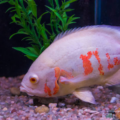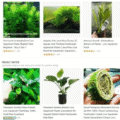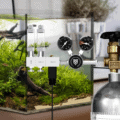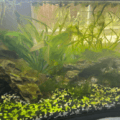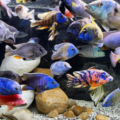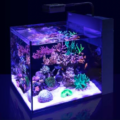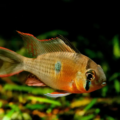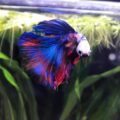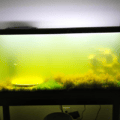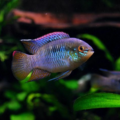A complete guide to caring for the bright yellow Lake Tanganyika Lemon Cichlid, famous for its unique breeding traits and colorful scales, learn everything you need to care for these beauties from tank setup to signs of illness and breeding.

Neolamprologus leleupi: The Bright Jewel of Lake Tanganyika
Are you searching for one aquarium fish that’ll blow every other species out of the water? Then, you’ll love this Tanganyika Cichlid profile I’m about to introduce to you.
Neolamprologus lelupi, or Lemon Cichcild, has a striking yellow coloration and elegant behavior suitable for intermediate aquarists. Its physical features attract watchers to your tank, and its unique traits keep their eyes glued to the aquarium. You need to learn special Neolamprologus leleupi care tips to keep this species safe, healthy, and vibrant all year round.
Don’t worry, this Lemon Cichlid overview contains every detail, from its appearance to habitat, feeding, breeding, health, tank mates, and longevity.
See Also: 15 Dwarf Cichlids for a Peaceful Community Aquarium for more dwarf cichlid varieties.
The Vibrant Appearance of Neolamprologus Leleupi
We’re opening this overview with a closer look at this colorful Tanganyika fish because initial identification matters. Male and female Neolamprologus leleupi typically look alike and they stretch up to 7-10cm long when fully grown.
Color Pattern

Lemon Cichlid have scales with subtle variations of yellow tones from pale to vibrant and sometimes a deep orange, depending on their diets and health status.
See Also: The Ultimate Guide to Lemon Oscar Care, if you want to explore other lemon colored fish species.
Unique Traits
You have a better chance of identifying Lemon Cichlids with their unique traits like their fin structure, size difference, behavior, and venting.
Check out this table for a better understanding of this method of identification.
| Male | Female | |
| Size | Larger and Robust | Smaller and Slender unless they’re breeding |
| Anal and Dorsal Fins | Long and Pointed | Short and Round |
| Breeding Patterns | Territorial, Dominant, and Aggressive | Calm and Hidden |
| Venting (Physical Genital Check) | Small and Pointed genital papilla | Large and Rounded genital papilla |
You can now identify the Neolamprologus leleupi using its appearance, so let’s move on to its living conditions.
Setting Up a Suitable habitat for Neolamprologus leleupi
In creating the optimal aquarium layout for Neolamprologus leleupi you must draw inspiration from its natural habitat.
So your Lemon Cichlid tank setup, from its size to the water parameters, substrate, decor, and other features, must mimic the Tanganyika Cichlid habitat.
Tank Size and Layout

Lemon Cichlids need a minimum tank size of 20 gallons per pair with a rectangular shape. The rocky territories and crevices in the tank should not interfere with your pet’s movement to avoid injuries and discomfort that can cause illness.
Water Parameters
Stabilize the water parameters at the following levels to recreate the hardness of the Lake Tanganyika waters.
| Temperature | 75 – 81℉ |
| pH | 7.5 – 9 |
| Hardness | 8 – 20 dGH |
For periodic cleaning, you can stabilize these parameters using a strong filtration system, with moderate water flow. It’ll ensure the water stays breathable with oxygen for your Lemon Cichlids.
Substrate and Decor
Add sandy substrates and rock formations to your tank to boost its natural aesthetics. The rocky structure are ideal for hiding during breeding and when your pets feel stressed from socialization.
Feeding Neolamprologus leleupi: A Balanced Diet for Vibrant Colors
Every Neolamprologus leleupi diet guide will tell you that this species is omnivorous. But they won’t tell you about their carnivorous preferences and how to balance high-protein cichlid nutrition for color enhancement and vitality with basic staples and supplements.
Diet Suggestions
So, here’s an ideal chart of diet suggestions for feeding lemon cichlids and ensuring they meet all their nutritional needs.
| Staples | Protein | Supplements |
| Pellets and Flakes specifically for cichlids. | Live or Frozen food like Brine Shrimp, Bloodworms, and Daphnia | Blanched vegetables like Spinach or Spirulina. |
For more on feeding your aquatic pets check out The Ultimate Guide to Fish Food: Pros and Cons & Best Choices!
Feeding Tips
Regulate the food portions they consume to quantities your Lemon Cichlid can finish in less than 3 minutes and feed them only 2-3 times daily.
Breeding Neolamprologus leleupi: A Guide to Spawning Success

This species hides in their caves when it’s time to spawn! You’ll get it soon, but first, check out this ideal setup for breeding Lemon Cichlids.
Breeding Setup
Choosing your breeding pair usually occurs organically as your lemon cichlids would naturally select a partner. Then maintain stable water conditions using the same parameters as above mentioned in the previous section. Finally, use these Neolamprologus leleupi spawning tips for better results:
- Place a flat surface like a large leaf or ceramic saucer in the cave for spawning
- Clean the area
- Feed your pets a protein-rich diet to prepare their bodies for breeding.
The male Lemon Cichlid enters the cave to fertilize the spawned eggs, and together with the female, they guard their offspring until they hatch.
Fry Care Tips
Within three to four days, your Lemon Cichlid eggs will hatch, and then you must take over the Lake Tanganyika Cichlid fry care from the adult breeders. Feed the fry with finely crushed powdered fry flakes and baby brine shrimp for protein.
Watch them grow and separate large fry from smaller ones until they’re all mature and ready to join the community tank.
Tank Mates for Neolamprologus leleupi: Finding Compatibility
Choose compatible species for Neolamprologus leleupi if you want them to survive in a community tank. Naturally, this species is a peaceful Tanganyika community fish but they can get territorial and aggressive under ceratiain conditions. So, here are some factors to consider when choosing tank mates for Lemon Cichlids:
- Size
- Environmental needs
- Temperament
Using those determinants, other Tanganyika cichlids like Altolamprologus and Julidochromis are compatible species, while aggressive, larger, or smaller fish should be avoided species.
Preventing Health Issues in Neolamprologus leleupi
Following this guide so far is your first step in perfecting Neolamprologus leleupi health care, but you can do more.
Preventative Measures
Periodic water changes of 20-30% weekly, stabilizing water conditions, feeding a balanced diet, and avoiding overcrowding that can lead to stress or contagious ailments are the best practices for preventing Cichlid disease.
Signs of Illness
| Symptoms | Illness | Causes | Treatment |
| White spots, Rubbing, Rapid Gill Movement | White Spot | Stress, Temperature Changes | Increase water temperature to 82 – 86℉ and Ich treatment |
| Swollen abdomen, Appetite loss, Stringy feces | Bloat | Protozoa infection, Overfeeding, Poor Diet | Improve diet, a day of fasting, medication |
| Pits or Erosion on the head | Hole-in-the-Head | Poor water quality, Hexamita, and Nutritional deficiencies | Improve water conditions, feed a balanced diet, use medication for Hexamita |
Check out How to Treat Ich Outbreaks in Your Freshwater Fish for more information on Ich!
Knowing the signs, causes, and treatment of illnesses is good but you may not need them if you follow my healthy Lemon Cichlid tips highlighted above.
Lifespan of Neolamprologus leleupi: Caring for Long-Term Companions
This article is a Lemon Cichlid lifespan guide because it shows you the best long-term care for Neolamprologus leleupi species.
Lifespan Factors
- Water conditions
- Diet
- Environment
Care Tips for Longevity
Maintaining healthy cichlids that’ll live about 8-10 years in captivity is by ensuring you have optimal conditions of all lifespan factors. No more, no less.
Conclusion
We’ve wrapped up yet another exciting chat on hardy water dwellers with this complete Tanganyika fish care review. Each of these Lemon Cichlid aquarium tips is the key to having a successful tank, so please don’t skip any step.
All factors are intertwined, from the knowledge of the Lemon Cichlid’s appearance, you can easily identify changes pointing to health issues and how poor water quality and diets can affect breeding and overall health.
Luckily, this Neolamprologous leleupi care guide has all the details you need as a beginner, intermediate, or expert fish keeper.

